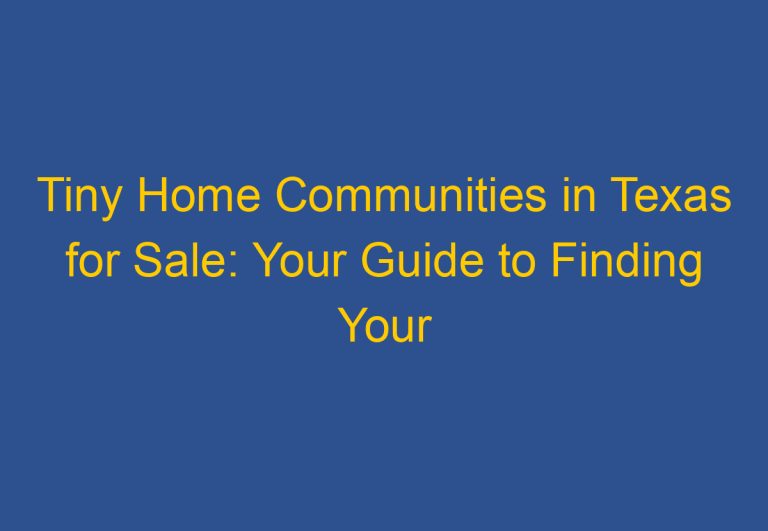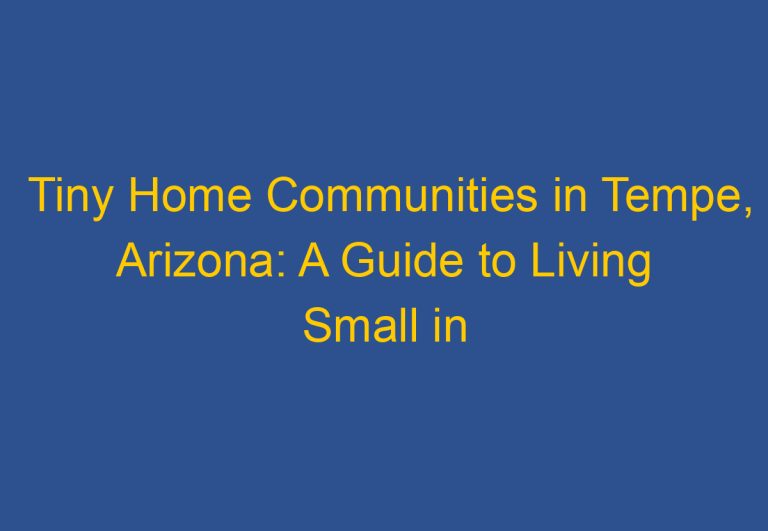Tiny Home Communities in Maine: A Guide to Finding Your Perfect Community
Maine is a state known for its natural beauty and vast wilderness, making it a popular destination for those looking to escape the hustle and bustle of city life. One trend that has become increasingly popular in recent years is tiny home living. Tiny homes are typically less than 400 square feet and offer a minimalist lifestyle that is both affordable and eco-friendly.
For those interested in tiny home living, Maine offers a number of tiny home communities that provide modern amenities, eco-friendly features, and shared outdoor spaces. These communities are designed to provide a sense of community and offer a unique way of living that is different from traditional homes.
Whether you’re looking for waterfront views or mountain ranges, Maine has a variety of tiny home communities to choose from. These communities offer a range of benefits, including reduced living expenses, a smaller carbon footprint, and a simpler lifestyle. In this article, we will explore the top 10 tiny home communities in Maine and their advantages and disadvantages.
Benefits of Tiny Home Living in Maine
Affordability and Savings
One of the main benefits of living in a tiny home community in Maine is the affordability factor. Tiny homes are generally more affordable than traditional homes, and living in a tiny home community can offer even more savings. Residents can share communal facilities like laundry rooms and gardens, which can help reduce individual costs. Additionally, many tiny home communities in Maine are designed to be eco-friendly, which can translate into savings on energy bills.
Proximity to Natural Beauty
Maine is known for its stunning natural beauty, and living in a tiny home community can offer residents the chance to be closer to nature. Many tiny home communities are located in picturesque areas, such as near the coast or in the mountains. Residents can enjoy hiking, fishing, kayaking, and other outdoor activities right in their backyard. Being surrounded by nature can also have a positive impact on mental health and well-being.
Community and Lifestyle
Living in a tiny home community in Maine can offer a unique and fulfilling lifestyle. Residents often share a sense of community and camaraderie, and many communities offer social events and gatherings. The tiny home lifestyle encourages minimalism and simplicity, which can lead to a more intentional and fulfilling way of living. Additionally, many tiny home communities in Maine are designed to be sustainable and eco-friendly, which can align with residents’ values and beliefs.
Overall, living in a tiny home community in Maine can offer a range of benefits, from affordability and savings to proximity to natural beauty and a unique lifestyle.
Legal Framework and Zoning Ordinances
When it comes to tiny home communities in Maine, it is important to understand the legal framework and zoning ordinances that govern their construction and placement. This section will provide an overview of the state regulations and local zoning laws that apply to tiny homes in Maine.
State Regulations and Application Process
In July 2021, Maine Governor Janet Mills signed a law that outlines the specific rules and regulations for Maine residents building or buying tiny homes. These guidelines are designed to protect both the homeowner and the public and provide a safe and legal way for individuals to enjoy the benefits of tiny home living.
Under the law, municipalities are required to permit a tiny home to be placed or erected on an individual house lot where single-family dwellings are allowed or as an accessory structure, subject to all applicable land use requirements as single-family dwellings or as an accessory structure. The law also defines a “tiny home” as having the same meaning as in Title 29-A, section 101, subsection.
Individuals looking to build or buy a tiny home in Maine should consult with their local municipality to ensure that they are complying with all applicable regulations and requirements.
Local Zoning Laws in Key Locations
While the state of Maine has established regulations for tiny homes, local zoning laws can vary depending on the location. Here are some examples of local zoning laws in key locations:
-
Portland: The city of Portland allows tiny homes as accessory dwelling units on residential properties, subject to certain requirements such as minimum lot size and setbacks.
-
Bangor: The city of Bangor allows tiny homes as accessory dwelling units on residential properties, subject to certain requirements such as minimum lot size and setbacks.
-
York: The town of York allows tiny homes as accessory dwelling units on residential properties, subject to certain requirements such as minimum lot size and setbacks.
-
Belfast: The city of Belfast allows tiny homes as accessory dwelling units on residential properties, subject to certain requirements such as minimum lot size and setbacks.
Overall, individuals looking to build or buy a tiny home in Maine should consult with their local municipality to ensure that they are complying with all applicable regulations and requirements. By following these regulations, individuals can enjoy the benefits of tiny home living while ensuring the safety and well-being of themselves and their community.
Types of Tiny Home Communities in Maine
When it comes to tiny home communities in Maine, there are three main types that one can choose from: RV parks and tiny house-friendly campgrounds, dedicated tiny home villages, and mixed housing developments.
RV Parks and Tiny House-Friendly Campgrounds
Maine has many RV parks and campgrounds that are tiny home-friendly. These parks offer a range of amenities, including access to outdoor activities, such as hiking and fishing. Some of the popular RV parks and campgrounds in Maine include Sebago Lake State Park, which offers over 200 campsites and is located on the shores of Sebago Lake, and Mount Desert Campground, which is located near Acadia National Park.
Dedicated Tiny Home Villages
For those who are looking for a more permanent tiny home community, there are dedicated tiny home villages in Maine. These villages are designed for those who want to live in a tiny home full-time and offer a range of amenities, including community gardens and shared spaces. Some of the popular dedicated tiny home villages in Maine include The Preserve at Timber Hill, which is located in Topsham and offers waterfront views and access to nearby trails, and the tiny home community in Bangor, which has around 200 applicants wanting to call one of the minimalist homes their own.
Mixed Housing Developments
Mixed housing developments are another option for those who are interested in tiny home living in Maine. These developments offer a mix of tiny homes and other types of housing, such as apartments and townhouses. Some of the popular mixed housing developments in Maine include the Village at Oceans End, which is located in York and offers a mix of tiny homes and other types of housing, and the Brunswick Landing Village, which is located in Brunswick and offers a mix of tiny homes, apartments, and townhouses.
Overall, Maine has a variety of tiny home communities to choose from, whether you are looking for a temporary or permanent living situation. With its beautiful natural scenery, access to outdoor activities, and growing housing stock, Maine is a great place to consider for your tiny home living needs.
How to Join or Create a Tiny Home Community
If you’re interested in joining or creating a tiny home community in Maine, there are a few things to consider. Finding the right location and land, designing and constructing your tiny home, and networking with hosts and community members are all important factors to keep in mind.
Finding the Right Location and Land
The first step in creating or joining a tiny home community is finding the right location and land. There are a few options available when it comes to land ownership, including purchasing or renting. It’s important to research zoning laws and regulations in your desired area to ensure that your tiny home community is legal and up to code.
Design, Construction, and Customization
Design, construction, and customization are also important factors to consider when creating or joining a tiny home community. You’ll need to assemble a crew of skilled workers to help with the construction process, and decide on finishes and materials that fit your modern and steel aesthetic.
Networking with Hosts and Community Members
Networking with hosts and community members is another important aspect of creating or joining a tiny home community. You’ll want to connect with like-minded individuals who share your passion for tiny home living and work together to create a sustainable and supportive community.
Whether you’re looking to join an existing tiny home community or create your own, there are many resources available to help you get started. With careful planning and a supportive network of hosts and community members, you can create the perfect tiny home community in Maine.
Frequently Asked Questions
What are the top-rated tiny home communities in Maine?
Maine has several top-rated tiny home communities, including Seabrook in Kittery, which offers modern-designed homes with access to amenities such as a pool, clubhouse, and fitness center. Another top-rated community is Sebago Lake Village, which offers lakefront homes with access to a private beach, boat launch, and dock. Additionally, there are several movable tiny home-friendly RV parks and mobile home parks that allow tiny homes.
Are there any lakefront tiny houses available for purchase in Maine?
Yes, there are several lakefront tiny houses available for purchase in Maine. Sebago Lake Village is a community that offers lakefront homes for sale, as well as access to a private beach, boat launch, and dock. Other lakefront tiny homes can be found through online real estate listings or by contacting local real estate agents.
How can one find tiny homes for sale in Maine that include land?
To find tiny homes for sale in Maine that include land, one can search online real estate listings or contact local real estate agents. Some tiny home communities, such as Sebago Lake Village, offer homes for sale that include land. It is important to research local zoning laws and building codes to ensure that the land and home are in compliance.
What is the average cost of a tiny house in Maine?
The average cost of a tiny house in Maine varies depending on several factors, including size, location, and amenities. On average, a tiny house in Maine can range from $30,000 to $100,000 or more. It is important to research local real estate listings and consult with a real estate agent to determine the cost of a specific tiny home.
Are there specific areas in Maine that are zoned for tiny house living?
Maine does not have specific zoning laws for tiny house living, but some areas may be more favorable than others. It is important to research local zoning laws and building codes to ensure that a tiny home is in compliance. Some communities, such as Sebago Lake Village, have already been approved for tiny home living.
Is it legal to live in a tiny home year-round in Maine?
Yes, it is legal to live in a tiny home year-round in Maine, but it is important to research local zoning laws and building codes to ensure that the home is in compliance. Some areas may have restrictions on the size of a home or require a minimum square footage for a permanent dwelling. It is important to consult with a real estate agent or local government officials to determine the requirements for year-round living in a tiny home.












